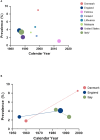The epidemiology of cryptorchidism and potential risk factors, including endocrine disrupting chemicals
- PMID: 38633762
- PMCID: PMC11021654
- DOI: 10.3389/fendo.2024.1343887
The epidemiology of cryptorchidism and potential risk factors, including endocrine disrupting chemicals
Abstract
Congenital cryptorchidism, also known as undescended testis, is the condition where one or both testes are not in place in the scrotum at birth and is one of the most common birth defects in boys. Temporal trends and geographic variation in the prevalence of cryptorchidism from 1% to 9% have been reported in prospective cohort studies. The testes develop in the abdominal cavity and descend to the scrotum in two phases, which should be completed by gestational week 35. Thus, the risk of cryptorchidism is higher in preterm boys. In many cases a spontaneous descent occurs during the first months of life during the surge of gonadotropins and testosterone. If not, the testis is usually brought down to the scrotum, typically by surgery, to increase future fertility chances and facilitate cancer surveillance. The increasing frequency of impaired semen quality and testicular cancer, with which cryptorchidism is associated, represents a concern for male reproductive health in general and a need to understand its risk factors. The risk of cryptorchidism is closely related to gestational factors (preterm birth, low birth weight and intrauterine growth restriction), and especially maternal smoking seems to be a risk factor. Evidence is accumulating that the increasing prevalence of cryptorchidism is also related to prenatal exposure to environmental chemicals, including endocrine disrupting compounds. This association has been corroborated in rodents and supported by ecological studies. Conducting human studies to assess the effect of endocrine disrupting chemicals and their interactions is, however, challenged by the widespread concomitant exposure of all humans to a wide range of chemicals, the combined effect of which and their interactions are highly complex.
Keywords: cryptorchidism; endocrine disrupting compounds; epidemiology; prenatal exposure; testicular dysgenesis.
Copyright © 2024 Holmboe, Beck, Andersson, Main, Jørgensen, Skakkebæk and Priskorn.
Conflict of interest statement
The authors declare that the research was conducted in the absence of any commercial or financial relationships that could be construed as a potential conflict of interest.
Figures
Similar articles
-
Effects of the prenatal environment on cryptorchidism: A narrative review.Int J Urol. 2021 Sep;28(9):882-889. doi: 10.1111/iju.14600. Epub 2021 Jun 1. Int J Urol. 2021. PMID: 34075642 Review.
-
Cryptorchidism and hypospadias as a sign of testicular dysgenesis syndrome (TDS): environmental connection.Birth Defects Res A Clin Mol Teratol. 2010 Oct;88(10):910-9. doi: 10.1002/bdra.20707. Birth Defects Res A Clin Mol Teratol. 2010. PMID: 20865786 Review.
-
Endocrine Disrupting Chemicals and Reproductive Health in Boys and Men.Front Endocrinol (Lausanne). 2021 Oct 7;12:706532. doi: 10.3389/fendo.2021.706532. eCollection 2021. Front Endocrinol (Lausanne). 2021. PMID: 34690925 Free PMC article. Review.
-
The epidemiologic evidence linking prenatal and postnatal exposure to endocrine disrupting chemicals with male reproductive disorders: a systematic review and meta-analysis.Hum Reprod Update. 2016 Dec;23(1):104-125. doi: 10.1093/humupd/dmw036. Epub 2016 Sep 21. Hum Reprod Update. 2016. PMID: 27655588 Free PMC article. Review.
-
Shorter anogenital distance correlates with undescended testis: a detailed genital anthropometric analysis in human newborns.Hum Reprod. 2013 Sep;28(9):2343-9. doi: 10.1093/humrep/det286. Epub 2013 Jul 9. Hum Reprod. 2013. PMID: 23838161
Cited by
-
Reproductive toxicology: keeping up with our changing world.Front Toxicol. 2024 Oct 11;6:1456687. doi: 10.3389/ftox.2024.1456687. eCollection 2024. Front Toxicol. 2024. PMID: 39463893 Free PMC article.
References
-
- Leslie SW, Sajjiad H, Villaneuva CA. Cryptorchidism. In: StatPearls. Treasure Island (FL): StatPearls Publishing; (2023).
-
- Hutson JM. Cryptorchidism and hypospadias. Feingold KR, Anawalt B, Blackman MR, Boyce A, Chrousos G, Corpas E, et al., editors. South Dartmouth (MA): MDText.com; (2000).
Publication types
MeSH terms
Substances
Grants and funding
LinkOut - more resources
Full Text Sources
Medical


